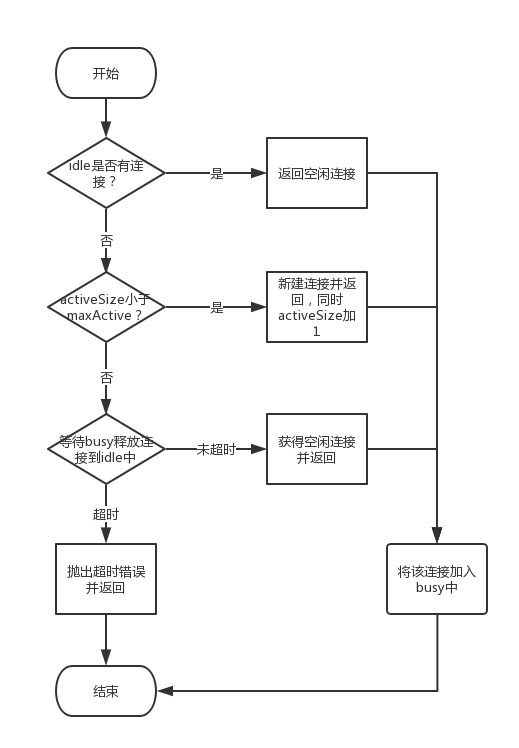java并发实战:连接池实现
2024-08-25 05:34:23
池化技术简介
在我们使用数据库的过程中,我们往往使用数据库连接池而不是直接使用数据库连接进行操作,这是因为每一个数据库连接的创建和销毁的代价是昂贵的,而池化技术则预先创建了资源,这些资源是可复用的,这样就保证了在多用户情况下只能使用指定数目的资源,避免了一个用户创建一个连接资源,造成程序运行开销过大。关于Java并发编程的总结和思考
连接池实现原理
这里只实现一个简易的连接池,更多复杂的需求可根据该连接池进行改进,该连接池主要参数如下:
- 一个繁忙队列busy
- 一个空闲队列idle
- 连接池最大活动连接数maxActive
- 连接池最大等待时间maxWait
- 连接池的活动连接数activeSize
程序流程图如下:

代码实现
泛型接口ConnectionPool.java
public interface ConnectionPool<T> {
/**
* 初始化池资源
* @param maxActive 池中最大活动连接数
* @param maxWait 最大等待时间
*/
void init(Integer maxActive, Long maxWait);
/**
* 从池中获取资源
* @return 连接资源
*/
T getResource() throws Exception;
/**
* 释放连接
* @param connection 正在使用的连接
*/
void release(T connection) throws Exception;
/**
* 释放连接池资源
*/
void close();
}
以zookeeper为例,实现zookeeper连接池,ZookeeperConnectionPool.java
public class ZookeeperConnectionPool implements ConnectionPool<ZooKeeper> {
//最大活动连接数
private Integer maxActive;
//最大等待时间
private Long maxWait;
//空闲队列
private LinkedBlockingQueue<ZooKeeper> idle = new LinkedBlockingQueue<>();
//繁忙队列
private LinkedBlockingQueue<ZooKeeper> busy = new LinkedBlockingQueue<>();
//连接池活动连接数
private AtomicInteger activeSize = new AtomicInteger(0);
//连接池关闭标记
private AtomicBoolean isClosed = new AtomicBoolean(false);
//总共获取的连接记数
private AtomicInteger createCount = new AtomicInteger(0);
//等待zookeeper客户端创建完成的计数器
private static ThreadLocal<CountDownLatch> latchThreadLocal = ThreadLocal.withInitial(() -> new CountDownLatch(1));
public ZookeeperConnectionPool(Integer maxActive, Long maxWait) {
this.init(maxActive, maxWait);
}
@Override
public void init(Integer maxActive, Long maxWait) {
this.maxActive = maxActive;
this.maxWait = maxWait;
}
@Override
public ZooKeeper getResource() throws Exception {
ZooKeeper zooKeeper;
Long nowTime = System.currentTimeMillis();
final CountDownLatch countDownLatch = latchThreadLocal.get();
//空闲队列idle是否有连接
if ((zooKeeper = idle.poll()) == null) {
//判断池中连接数是否小于maxActive
if (activeSize.get() < maxActive) {
//先增加池中连接数后判断是否小于等于maxActive
if (activeSize.incrementAndGet() <= maxActive) {
//创建zookeeper连接
zooKeeper = new ZooKeeper("localhost", 5000, (watch) -> {
if (watch.getState() == Watcher.Event.KeeperState.SyncConnected) {
countDownLatch.countDown();
}
});
countDownLatch.await();
System.out.println("Thread:" + Thread.currentThread().getId() + "获取连接:" + createCount.incrementAndGet() + "条");
busy.offer(zooKeeper);
return zooKeeper;
} else {
//如增加后发现大于maxActive则减去增加的
activeSize.decrementAndGet();
}
}
//若活动线程已满则等待busy队列释放连接
try {
System.out.println("Thread:" + Thread.currentThread().getId() + "等待获取空闲资源");
Long waitTime = maxWait - (System.currentTimeMillis() - nowTime);
zooKeeper = idle.poll(waitTime, TimeUnit.MILLISECONDS);
} catch (InterruptedException e) {
throw new Exception("等待异常");
}
//判断是否超时
if (zooKeeper != null) {
System.out.println("Thread:" + Thread.currentThread().getId() + "获取连接:" + createCount.incrementAndGet() + "条");
busy.offer(zooKeeper);
return zooKeeper;
} else {
System.out.println("Thread:" + Thread.currentThread().getId() + "获取连接超时,请重试!");
throw new Exception("Thread:" + Thread.currentThread().getId() + "获取连接超时,请重试!");
}
}
//空闲队列有连接,直接返回
busy.offer(zooKeeper);
return zooKeeper;
}
@Override
public void release(ZooKeeper connection) throws Exception {
if (connection == null) {
System.out.println("connection 为空");
return;
}
if (busy.remove(connection)){
idle.offer(connection);
} else {
activeSize.decrementAndGet();
throw new Exception("释放失败");
}
}
@Override
public void close() {
if (isClosed.compareAndSet(false, true)) {
idle.forEach((zooKeeper) -> {
try {
zooKeeper.close();
} catch (InterruptedException e) {
e.printStackTrace();
}
});
busy.forEach((zooKeeper) -> {
try {
zooKeeper.close();
} catch (InterruptedException e) {
e.printStackTrace();
}
});
}
}
}
测试用例
这里创建20个线程并发测试连接池,Test.java
public class Test {
public static void main(String[] args) throws Exception {
int threadCount = 20;
Integer maxActive = 10;
Long maxWait = 10000L;
ZookeeperConnectionPool pool = new ZookeeperConnectionPool(maxActive, maxWait);
CountDownLatch countDownLatch = new CountDownLatch(20);
for (int i = 0; i < threadCount; i++) {
new Thread(() -> {
countDownLatch.countDown();
try {
countDownLatch.await();
ZooKeeper zooKeeper = pool.getResource();
Thread.sleep(2000);
pool.release(zooKeeper);
} catch (InterruptedException e) {
e.printStackTrace();
} catch (Exception e) {
e.printStackTrace();
}
}).start();
}
while (true){
}
}
}
来源:https://segmentfault.com/a/1190000017926611
最新文章
- webmagic 增量爬取
- LLBL Gen Pro 4.2 Lite 免费的对象关系映射开发框架与工具
- WCF初探-9:WCF服务承载 (下)
- html3秒跳转
- solr学习之入门篇
- zabbix3.0 安装方法,一键实现短信、电话、微信、APP 告警
- Hadoop应用开发实战案例 第1周
- php截取小时和分钟,在进行和其它时间段的比较
- C语言-07其它相关
- 程序员欢呼:微软Bing开始支持搜索源码、可直接运行!
- Android中view的事件
- HDU3257 Hello World!
- 【算法】论平衡二叉树(AVL)的正确种植方法
- Docker系列01—容器的发展历程---Docker的生态圈
- Unity3D 物体移动方法总结
- mysql之整合ssm多数据源配置
- Python基础之带你快速掌握列表的常用方法
- 黄聪:浓缩的才是精华:浅析GIF格式图片的存储和压缩(转)
- Client Dataset Basics
- 如何通过Dreamweaver批量对整个站点或目录进行代码搜索或部分全部替换